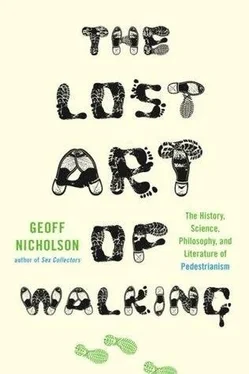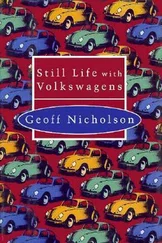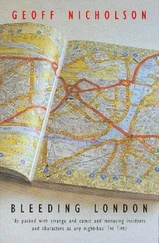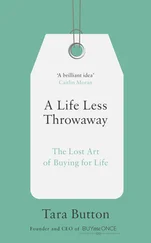Anderson and La Chapelle were members of a small group of professional ‘pedestriennes’. La Chapelle had turned pro at the age of thirteen. For a brief period in the nineteenth century female walking was a serious sport and a serious business. Large crowds turned out to watch, and successful women earned a great deal of money. Even so, it was an activity that had something sleazy and daring about it: pedestriennes weren’t much better than actresses. It was only a passing fad, however. It was superseded in due course by the more exciting, and even more daring, sport of female bicycle riding, and some of the successful female walkers made an easy transition from two feet to two wheels.
In the interests of research, I decided to do an extended one-mile-per-hour walk. It took place in England, in Suffolk, the county where Captain Barclay walked his thousand miles, but instead of Newmarket, I would be walking in the village of Yoxford, where I sometimes go to write. Suffolk has the great advantage of being flat.
My emulation of the captain was never going to be absolute. For one thing, I would be doing my walking on public paths and streets, not along a designated track. There would be no cheering crowds, nobody timing me, nobody wishing me well or ill, nobody providing me with roasted fowl and porter, nobody betting on my success or failure. Perhaps these things would have spurred me on.
Equally, I wouldn’t be walking a thousand miles, but I did want a taste of how it might feel to do even a fraction of what Barclay had done. I decided to start, with infinite modesty, by doing fifteen miles in fifteen hours. I knew I could complete a fifteen-mile walk easily enough. It was spreading those miles out over the day, with all the gaps and the waiting, the stopping and the starting, that I thought would be interesting and difficult. And I was dead right about that.
Walking slightly more slowly than the good captain, at more or less three miles per hour, twenty minutes per mile, doing the miles in pairs at the end and beginning of two consecutive hours, I would create a pattern of walking for forty minutes and resting for eighty. That didn’t seem too arduous. In fact I thought I could use those rest periods to do some writing, make phone calls, read a book, and so on. I was dead wrong about that.
Yoxford is an interesting little village — peaceful, picturesque, population less than seven hundred. There’s a former country house, now a hotel-cum-Malaysian restaurant called Satis House, where Charles Dickens almost certainly stayed, and he used the name Satis House for Miss Havisham’s home in Great Expectations . Since Dickens was a manic walker there’s every reason to believe he walked in the very places that I did.
Yoxford is also where W.G. Sebald begins one of the cosmically melancholy walks in his book The Rings of Saturn . He writes:
‘I set out on foot…along the old Roman road, into the thinly populated countryside…I walked for nearly four hours, and in all that time I saw nothing apart from harvested cornfields stretching away into the distance under a sky heavy with clouds, and dark islands of trees.’
I’m pretty sure he’s wrong about the Roman road starting at Yoxford. There is a good, straight Roman road nearby, but it’s some way to the west of the village. However, the gloom he describes, which seems to be internal as much as external, sounds accurate enough.
A walk around Yoxford, therefore, has its historical and literary pleasures, but when you’re following in Captain Barclay’s footsteps, you’re not very appreciative of such things. I simply set off from the house, walked briskly but aimlessly for a mile, as measured by my GPS, then stopped and went right back. This felt peculiar and arrhythmic, and frankly I was worried about what the neighbors might think.
Fortunately I didn’t see many neighbors — the cold, damp rain and occasional snow flurries kept them indoors. I varied my routes as much as I could: to the station and back, round the cricket pitch and the bowling green, up to the end of the village as far as the closed-down fish-and-chips shop. At one point I found myself at the end of a mile taking shelter under the trees in the local graveyard as the sleet lashed down on me from an ash gray sky, and I heard the sound of a farmer’s shotgun being repeatedly fired in the distance, at least I hoped it was the distance. This felt surprisingly good. There’s nothing like bleak, adverse conditions for raising a walker’s self-esteem.
As it got colder and wetter I walked more quickly, tensed up, head down, shoulders raised, hands shoved into pockets — very much not the Barclay style. Before long I was chilled through and my back was aching, but I carried on.
It soon became apparent that my plan to do something in the nonwalking periods wasn’t going to work. It became impossible to think about anything except the next walk. I also discovered that waiting to walk is far more arduous than walking.
I did my fifteen miles in fifteen hours without any physical difficulty, and with some satisfaction, but the real satisfaction came from conquering the difficulties imposed by the frustrating stop-start pattern that Barclay’s walk had imposed on him, and on me. Walking at a set pace, making sure each mile was completed inside each designated hour, then stopping, then waiting, then getting ready to walk again, required a discipline and an attention to detail that was quite at odds with the way I (or I imagine anybody else) usually walk. In that sense it was some of the hardest walking I’d ever done.
I did another similar walk in midsummer, and it was a little easier than the one done in winter, but not much. There were pleasures, but they weren’t much like the ones that normally go with a good walk, and the fact is, notions of walking pleasure really didn’t mean much to Captain Barclay. For him a walk was all about testing himself, and others, to the limit. He wanted to demonstrate his strength and stamina. He wanted to beat his competitors, and ultimately he had none. This undoubtedly made him a great walker, and an admirable one, but a walker who was sui generis and one that few mortals can imitate.
♦
One thing that helped me to get through my Captain Barclay walks was making a record of my progress. It loosely resembled the one in the book Pedestrianism . I made a table that charted the time I set off for each walk, the time it took me to walk each mile, the speed, the total time spent walking, and the overall average speed. For instance, it took me four hours, thirty-four minutes, and eighteen seconds to walk the fifteen miles, which by my calculation averages 3.34 mph. Filling in this table, seeing the lines and columns gradually fill up, then doing the calculations, was a great source of enjoyment, at least as much as the walk itself.
There’s surely something contradictory, though not unnatural, about the desire to document and memorialize walking. What could be more transitory and ephemeral than a walk? In one sense, the best you might hope for would be to leave some footsteps, and the current environmental wisdom might suggest that footsteps are precisely all you should leave. No doubt there are those who think the ‘interventions’ that Richard Long makes in the landscape as he walks are a sacrilege.
The rest of us take photographs, shoot video, make drawings, write about it, fill in walking logs, and so on, and I’ve spent a certain amount of time wondering whether this is eccentric or not. Maybe all walking is eccentric — maybe none of it is.
♦
One of the most unlikely reasons I can think of for walking is because the president, any president, advocates it. In 1962, John F. Kennedy, recently come to office, discovered an executive order issued by Theodore Roosevelt in 1956, stating that any self-respecting U.S. Marine ought to be able to walk fifty miles in twenty hours with full pack. Kennedy reckoned that his marines should certainly be able to do anything Roosevelt’s marines could do, and asked his marine commandant to check on this. Kennedy also suggested that his White House staff ought to be able to do it, too.
Читать дальше












